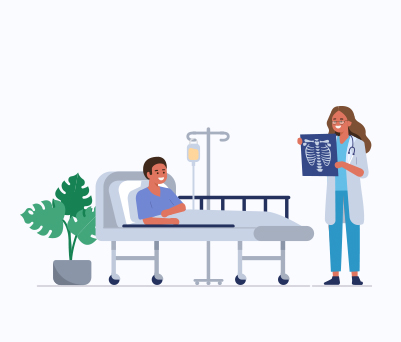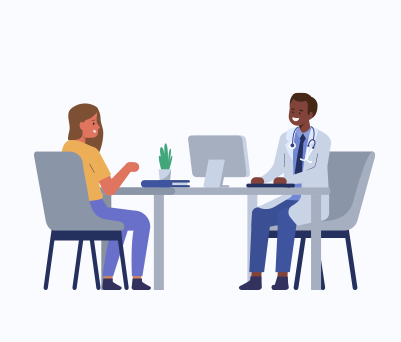Are you struggling to walk, sleep, or sit down because of pain that seems to be radiating from your lower back into your hips and down your legs? If so, you may be suffering from a condition called lumbar radiculopathy. It’s a complex term used to describe this type of debilitating pain that can stop you in your tracks. If you’re suffering from any type of nerve pain like this, you may not even know where it came from or what caused it, but you do know it hurts to function. The condition is one that is often treatable when you come in to see our experienced lumbar doctors in New York City.
When Should You See a Doctor?
Lumbar radiculopathy, which is often described as sciatica, isn’t the type of condition you can push to the side and just wait for it to improve. The symptoms you feel – including the pain that seems to be a flash that runs in a path into your leg – can improve. However, there is often a complex underlying problem that needs attention. Without medical attention, you may see this condition worsen over time and it could impact your mobility as well as your quality of life. Our NYC back doctors can offer you the pain solutions you need to get you back on your feet.
If you are struggling with this type of pain, whether it is mild or more severe, don’t put off getting the medical care you need. You may find that treatment options are more successful and easier when you address this concern sooner rather than later. Over time, you may develop worsening symptoms including weakness, the inability to stand or sit for long, and even bladder dysfunction.
When you come in to see our team, we’ll help you address the underlying cause of the pain, which could include a bulging disc or a problem with your spinal column alignment. And, we’ll help you to get back to health and well-being. You may see improvement sooner than you realize and can get back to living your life the way you would like to.
Lumbar radiculopathy is often defined as back pain that travels, spreads—radiates into the low back and sometimes the legs or feet (or both). Lumbar radiculopathy can develop suddenly or gradually as a result of lumbar disc herniation, spinal stenosis, or other spinal disorder that causes low back spinal nerve root compression, irritation and inflammation. Sciatica is a common term used to describe certain symptoms associated with a lumbar radiculopathy.
Characteristics of low back radiculopathy include:
- Pain: mild, achy, sharp, excruciating
- Laughing, coughing or sneezing aggravates pain
- Movement at the waist worsens pain.
- Sitting or walking often increases pain.
- Sensations: burning, numbness, tingling, pins and needles
- Weakness
- Bowel and/or bladder dysfunction (rare)*
*Loss of bowel and/or bladder control may be a symptom of cauda equina syndrome, a serious medical condition. Seek medical care immediately.
Lumbar nerves provide sensation, control function
There are five pairs of lumbar nerves. Where you feel back pain and symptoms depends on which spinal nerve root (or roots) is compressed. For example, if your third lumbar nerve root—abbreviated L3, is compressed, you may experience groin and inner thigh pain. L4 compression may cause pain at the front of your thigh, knee or upper leg. Your buttocks, left or right sides of your legs and back of one foot or the other is served by L5. Symptoms may include numbness or weakness.
You may feel skin surface numbness or tingling (or both) in certain areas. Where you feel skin sensation depends on which spinal nerve root is compressed. Each spinal nerve root serves a specific skin area called a dermatome. The map-like drawing below illustrates the body’s dermatomes.
Diagnostic examination
The purpose of the diagnostic examination is to locate the cause of your lumbar radiculopathy. Our staff will combine information learned about your general health, lifestyle, past medical history, and symptoms with imaging or other test results to confirm your diagnosis.
Questions our Doctors may ask include:
- When did lower-body pain and symptoms start?
- Did a particular event precede pain?
- Have pain and other symptoms improved or worsened?
- Does back pain radiate into another part of your body?
- On a scale of zero (no pain) to 10 (agony), what is your current pain level?
- How does lumbar radiculopathy affect your ability to work or perform ordinary activities of daily life?
- Do pain and symptoms disrupt your sleep?
- Other questions specifically related to you and your symptoms.
MRI is performed to evaluate your lumbar spine. Sometimes a plain x-ray is ordered. Depending on the results of your examination and MRI, our doctors may conduct electrodiagnostic studies.
Interventional treatment
Seldom does the cause of lumbar radiculopathy require spine surgery! We may combine non-operative interventional treatments to help resolve pain and improve mobility. Interventional means to ‘intervene’ to stop and manage pain while you heal.
Treatments are administered in a step-wise way. We believe less can be more, and the staff at Rehabilitation Medicine Center of New York applies that philosophy to our treatment approach. For example, a non-steroidal anti-inflammatory drug and physical therapy may be as effective as a narcotic painkiller, but with fewer side effects. However, no two patients are alike, and your low back radiculopathy may require more aggressive care.
Interventional treatments may include:
Expert interventional spine care
The medical experts at Rehabilitation Medicine Center of New York can help resolve the cause of your lumbar radiculopathy, pain and symptoms. Our friendly staff realizes you have questions—and take time necessary to provide answers using terms you can understand!













